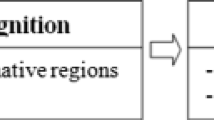Abstract
Face recognition has important applications in forensics (criminal identification) and security (biometric authentication). The problem of face recognition has been extensively studied in the computer vision community, from a variety of perspectives. A relatively new development is the use of facial asymmetry in face recognition, and we present here the results of a statistical investigation of this biometric. We first show how facial asymmetry information can be used to perform three different face recognition tasks—human identification (in the presence of expression variations), classification of faces by expression, and classification of individuals according to sex. Initially, we use a simple classification method, and conduct a feature analysis which shows the particular facial regions that play the dominant role in achieving these three entirely different classification goals. We then pursue human identification under expression changes in greater depth, since this is the most important task from a practical point of view. Two different ways of improving the performance of the simple classifier are then discussed: (i) feature combinations and (ii) the use of resampling techniques (bagging and random subspaces). With these modifications, we succeed in obtaining near perfect classification results on a database of 55 individuals, a statistically significant improvement over the initial results as seen by hypothesis tests of proportions.
Similar content being viewed by others
References
Anderson T.W. 1984. An Introduction to Multivariate Statistical Analysis, 2nd Edn. Wiley, New York.
Belhumeur P.N., Hespanha J.P., and Kriegman D. 1997. Eigenfaces vs. fisherfaces: Recognition using class specific linear projection. IEEE Transaction on Pattern Analysis and Machine Intelligence 19(7): 711–720.
Breiman L. 1996. Bagging predictors. Machine Learning 24(2): 123–140.
Burke P.H. and Healy M.J. 1993. A serial study of normal facial asymmetry in monozygotic twins. Annals of Human Biology 20(6): 527–534.
Freund Y. and Schapire R. 1997. A decision-theoretic generalization of online learning and an application to boosting. Journal of Computer and System Sciences 55(1): 119–139.
Hager J. and Ekman P. 1985. The asymmetry of facial actions is inconsistent with models of hemispheric specialization. Psychophysiology 22: 307–318.
Ho T.K. 1998. The random subspace method for constructing decision trees. IEEE Transactions on Pattern Analysis and Machine Intelligence 20(8): 832–844.
Kanade T., Cohn J.F., and Tian Y.L. 1999. Comprehensive database for facial expression analysis. In: 4th IEEE International Conference on Automatic and Gesture Recognition. Grenoble, Fr.
Lim J.S. 1990. Two-Dimensional Signal and Image Processing. Prentice Hall, New Jersey.
Liu Y. and Palmer J. 2003. A quantified study of facial asymmetry in 3d faces. In: Proceedings of the 2003 IEEE International Workshop on Analysis and Modeling of Faces and Gestures.
Liu Y., Schmidt K., Cohn J., and Mitra S. 2003. Facial asymmetry quantification for expression-invariant human identification. Computer Vision and Image Understanding Journal 91(1/2): 138–159.
Liu Y., Schmidt K., Cohn J., and Weaver R.L. 2002. Human facial asymmetry for expression-invariant facial identification. In: Proceedings of the Fifth IEEE International Conference on Automatic Face and Gesture Recognition (FG'02).
O'Toole. 1998. The perception of face gender: the role of stimulus structure in recognition and classification. Memory and Cognition 26(1): 146–160.
Skurichina M. and Duin R.P.W. 1998. Bagging for linear classifiers. Pattern Recognition 31(7): 909–930.
Skurichina M. and Duin R.P.W. 2000. Boosting in linear discriminant analysis. In: Lecture Notes in Computer Science. Vol. 1857. Springer-Verlag, Berlin.
Skurichina M. and Duin R.P.W. 2001. Bagging and the random subspace method for redundant feature spaces. In: Lecture Notes in Computer Science, Vol. 2096. Springer-Verlag, Berlin.
Thornhill R. and Gangstad S.W. (1999) Facial attractiveness. Transactions in Cognitive Sciences 3(12): 452–460.
Troje N.F. and Buelthoff H.H. 1998. How is bilateral symmetry of human faces used for recognition of novel views? Vision Research 38(1): 79–89.
Viola P. and Jones M. 2001. Robust real-time object detection. In: International Conference of Computer Vision.
Author information
Authors and Affiliations
Corresponding author
Rights and permissions
About this article
Cite this article
Mitra, S., Lazar, N.A. & Liu, Y. Understanding the role of facial asymmetry in human face identification. Stat Comput 17, 57–70 (2007). https://doi.org/10.1007/s11222-006-9004-9
Published:
Issue Date:
DOI: https://doi.org/10.1007/s11222-006-9004-9




